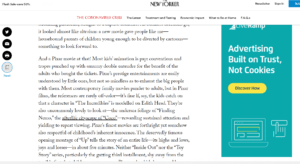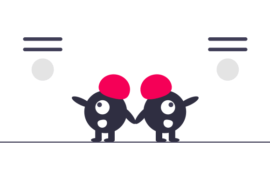Sticky ads persistently stick to the screen when a user browses the web page and offer better viewability. Here’s all about sticky ads and how to implement them in Google Ad Manager.
In times of bot traffic, ad fraud, and ad block, precious few ads make their way to real people who promptly scroll through the page – looking for something that catches their interest. The rise in digital advertising has provided publishers with a plethora of ad formats that can help in combating these issues.
Advertisers want conversions, and their ads are useless if there’s no one around to see them. For this reason, most advertisers would gladly pay a premium for ad impressions with a high viewability rate.
There’s also the case of banner blindness, which is a matter of concern for both publishers and advertisers. Here’s an expert roundup for publishers we did on reducing banner blindness.
Optimizing for viewability—without jeopardizing user experience can be tricky, but sticky ads walk that fine line with ease. Here’s all you need to know about them:
What are Sticky Ads?
Sticky ads are exactly what the name suggests: Ads that stick to the user’s screen even when users scroll the page in any direction. Also called anchor ads or adhesion ads, they are usually shown as banners or rectangles and are always visible to the users. Hence, regardless of the scroll depth, these ads will always be visible to the visitors.
Types of Sticky Ads
Normally, there are two types of sticky ads: Horizontal and Vertical. Google Ad Manager also supports these two types. Here’s how they look and their typical positioning.
Horizontal: These ads are present at the top (landscape) or the bottom of the webpage. Horizontal sticky ads generally come in leaderboard (728×90) sizes and include texts or images for advertising.

Vertical: Contrary to the landscape size of horizontal anchor ads, vertical ones are portrait-sized and exist on the sides of the web page.

Sticky Ads vs Banner Ads
Sticky ads and banner ads are both different ad formats in advertising but share subtle differences – in terms of their appearance on a webpage and effectiveness in capturing user attention.
Let’s first understand banner ads. As the name suggests, these ad formats appear rectangular and are placed at the top, bottom, or on either sides of the website to drive conversions. They are the most basic ad formats in the programmatic advertising industry.
On the contrary, sticky ads, or anchor ads, as the name suggests, anchor to the viewport while the user scrolls the webpage. Consider anchor ads a response to banner blindness, i.e., when a user deliberately refuses to engage with an ad as they are used to its placements. Sticky advertisements work well because they make sure the user sees the ad all the way through their browsing session, which can boost engagement rates.
Sticky Ad Sizes
Since almost any type of ad can be sticky, sticky ads do not have a standard size requirement designed expressly for them. Put differently, these can be displayed in regular display banner sizes because they are more of a feature than an ad style.
Some of the most popular sizes are:
- Medium rectangle (300×250) – They are commonly used for sidebar content, generate one of the highest CTRs, and give satisfactory performance in retargeting campaigns.
- Half-page/Vertical Ads (300×600) – Cover half of the page; one of the top performing ads due to their high visibility, but can be intrusive if not placed mindfully.
- Skyscraper (160×600) – These ads offer high visibility due to their prominent positioning and are equally mobile-friendly.
- Leaderboard (728×90) – Usually placed at the top or bottom of a website, these ads offer high versatility and are considered less intrusive.
Why Should Publishers use Sticky Ads? (Advantages of Sticky Ads)
Sticky ads offer benefits to both publisher and advertiser, such as increased ad visibility and dwell time, which leads to higher CPM for ad impressions. They can also overcome banner blindness without disrupting the user experience. Some other pros of sticky ads include:
- Adopting sticky ads can lead to increased web page monetization due to enhanced viewability.
- Since more than 50% of the creative pixels in sticky advertisements are visible for a second, they automatically meet the IAB and MRC ad viewability guidelines. The same has been mentioned in Google’s viewability guidelines as well.
- Unlike other ad formats like interstitial ads, these ads don’t disrupt the user’s browsing experience as they occupy the unused sections of the webpage and subtly stay in view.
- Sticky ads are highly versatile as they can be customized in any size or feature based on the advertiser’s campaign requirements.
- Sticky ad units are particularly popular for direct campaigns due to their high viewability, making your ad inventory attractive to advertisers, which can lead to direct deals.
- These ads can be included in header bidding and targeted in Google AdX.
What are the Disadvantages of Sticky Ads?
Like other ad formats, anchor ads also have cons attached to them. While both publishers and advertisers majorly prefer them, they come with their own set of disadvantages. Some cons of sticky ads are:
- Many platforms like Facebook, Google AdSense, and Google AdX have their own set of restrictions on the usage of anchor ads. Facebook doesn’t allow them, and violating their guidelines can lead to reduced reach. You will have to use AdSense’s anchor ad unit to serve sticky ads. Google AdX prohibits the display of more than one sticky ad, either horizontal or vertical, in the viewport at a time.
- They demand a high level of technical knowledge for customization and deployment.
- Large anchor ads can be overly intrusive, which can lead to a shoddy browsing experience.
- Pages with an overload of sticky advertising can lead to longer loading times.
- In many instances, anchor ads can negatively affect the performance of other ads.
How to Make the Most of Sticky Advertising?
Sticky advertising, if implemented mindfully, can be beneficial for both publishers and advertisers without disrupting the user experience. Here are some tips to make the most of sticky ads:
- Keep the aesthetics of the ads minimal and straight to the point. Avoid flashy color combinations or busy designs to keep the ads impactful.
- Always add a CTA (Call-to-action) to your ads.
- Maintain uniformity in the ad sizes.
What Data Says About Sticky Ads Performance
They perform significantly better than standard display ads for several reasons.
Now that ads are practically white noise to the online population, getting views and intentional clicks on ads, clicks that drive sales/conversions for advertisers and raise your traffic’s value on their graph – is a monumental task.
In the face of users’ complete indifference, well-implemented sticky ads refuse to be scrolled past and forgotten, and they do all this without being overly intrusive.
In our A/B testing and optimization experience*, sticky ads get:
- 40-60% Higher CTR: Compared to standard display (web) ads.
- Double Viewability: Up to 200% more viewable than other formats on the same placements.
- 30-70% Higher CPM: Advertisers shell out more for these ads. And that’s not all. Anchor ads improve a site’s average viewability and increase the CPM value of all ad formats over time.
* As seen in results from AdPushup’s Automated Layout Testing engine.
How to Implement Sticky or Anchor Ads in Google Ad Manager?
Within Google Display Network, these ads can be implemented on your standard web pages (desktop and mobile), Accelerated Mobile Pages (not the ultra-fast AMPHTML ads, just the usual AMP units), and in-app, making them one of the more versatile, high-yield ad formats in the market.
On-page placements can vary. Generally speaking, horizontal top/bottom sticky ads perform well on mobile. Vertical left/right ones are better suited for desktops’ wider screens.
Word of caution: Sticky ads must be used sparingly. Too many/too large anchor or sticky ds ads will stand in the way of content, and doing so can get publishers – especially AdX/AdSense media-sellers are blocked from serving any ads to Chrome users by Chrome’s Ad Filter.
Here are some reasonable constraints on their implementation:
- Width < 300 px
- Must cover less than 30% of the screen at any time (Chrome policy)
- One vertical sticky per viewport
- One horizontal sticky per page
- No cursor-associated movements (sticky ad must remain immobile)
- Plenty of whitespace/ boundary between the ad and content, so it’s distinguishable from the content.
There are a couple more guidelines for publishers using Ad Manager for sticky ad implementation, outlined on this Google Ad Manager support page.
Note that Google recommends not implementing these ads on gaming sites or pages with infinite scrolls for the sake of user experience.
We recommend testing these ads for affiliate promotions and, if you have any, for direct ad sales. Start by pitching the rates at a 50% premium over your average open auction CPMs and adjust based on demand.
How to Implement Sticky Ads in Ad Exchange?
Some ad networks do not allow running sticky ads on display, so it’s best to confirm with your ad network partner before getting started. These ads require a declaration in the ad exchanges you work with. Here’s how you can do the same in Google Ad Exchange:
- Sign in to your Google Ad Manager account.
- Click on Inventory >> AdExchange Rules >> Publisher Declarations
- For inventory type, click on Display.
- Click on New Display Publisher Declaration
- Enter a name for your declaration. The next step is to choose which inventory (for targeting) you want to exclude or include.
- Choose between horizontal and vertical ads under Sticky Ads
Publishers can choose to click on Save after this. But if they want to refresh inventory, here are the steps to do that:
Refresh Sticky Ads
- Click on the boxes under ‘Refresh Triggers’. This will make sure that the inventory you have selected refreshes.
- Specify the minimum time interval that you want between each refresh.
Finally, click on Save.
What About AdSense Publishers?
Google restricts the implementation of sticky ads on AdSense by an invite-only beta, typically reserved for a select few publishers. But that doesn’t mean the rest of AdSense publishers cannot introduce the format in their inventory.
Key Takeaways
- Sticky ads, unlike other ad formats, dock at the bottom of the screen while the user is scrolling the web page to maintain visibility and reduce banner blindness. These ads mainly come in two types: Horizontal sticky ads and Vertical sticky ads.
- Also called anchor ads, they are highly advantageous to publishers: meets the IAB and MRC guidelines viewability guidelines, complement user’s browsing experience, customizable, popular choice for direct campaigns, and can be included in header bidding.
- However, it also comes with its own set of cons: restrictions placed by Facebook, Google AdSense and Google AdX, high technical knowledge required, and longer loading time.
- According to AdPushup’s Automated Layout Testing Engine, sticky ads give almost 40-60% higher CTR compared to display ads, up to 200% more viewability than other formats, and 30-70% higher CPM than other formats.
- Sticky can be easily placed using Google Display Network. But, publishers should thoroughly go through Google’s guidelines to avoid penalties.
Are you ready to give your ad revenue a 40% guaranteed boost? Contact AdPushup today and experience ad revenue optimization at its peak with our AI-based solutions.
Frequently Asked Questions
In sticky ads, the ad stays visible on the page while the user scrolls through the content. The use of these ads can be very effective at increasing CTR and Active View metrics. CPMs will increase as viewability improves.
A sticky leaderboard ad is a horizontal banner ad that adheres to the top or bottom of the user’s viewport as they scroll up or down.
Sticky ads are not supported by all ad networks. Neither Facebook nor Google AdSense allow them unless you use their anchor ad units. Accounts of publishers can be banned if they violate these rules.








